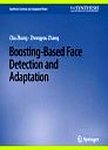版权所有:内蒙古大学图书馆 技术提供:维普资讯• 智图
内蒙古自治区呼和浩特市赛罕区大学西街235号 邮编: 010021

丛 书 名:Synthesis Lectures on Computer Vision
版本说明:1
I S B N:(纸本) 9783031006814
出 版 社:Springer Cham
出 版 年:1000年
页 数:XII, 132页
主 题 词:Computer Imaging, Vision, Pattern Recognition and Graphics Image Processing and Computer Vision Pattern Recognition
摘 要:Face detection, because of its vast array of applications, is one of the most active research areas in computer vision. In this book, we review various approaches to face detection developed in the past decade, with more emphasis on boosting-based learning algorithms. We then present a series of algorithms that are empowered by the statistical view of boosting and the concept of multiple instance learning. We start by describing a boosting learning framework that is capable to handle billions of training examples. It differs from traditional bootstrapping schemes in that no intermediate thresholds need to be set during training, yet the total number of negative examples used for feature selection remains constant and focused (on the poor performing ones). A multiple instance pruning scheme is then adopted to set the intermediate thresholds after boosting learning. This algorithm generates detectors that are both fast and accurate. We then present two multiple instance learning schemesfor face detection, multiple instance learning boosting (MILBoost) and winner-take-all multiple category boosting (WTA-McBoost). MILBoost addresses the uncertainty in accurately pinpointing the location of the object being detected, while WTA-McBoost addresses the uncertainty in determining the most appropriate subcategory label for multiview object detection. Both schemes can resolve the ambiguity of the labeling process and reduce outliers during training, which leads to improved detector performances. In many applications, a detector trained with generic data sets may not perform optimally in a new environment. We propose detection adaption, which is a promising solution for this problem. We present an adaptation scheme based on the Taylor expansion of the boosting learning objective function, and we propose to store the second order statistics of the generic training data for future adaptation. We show that with a small amount of labeled data in the new environment, the detector spe